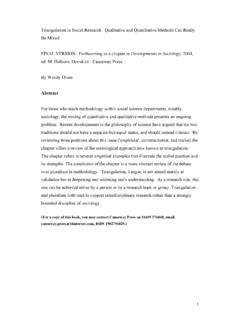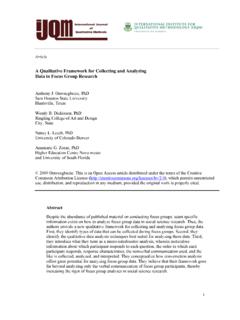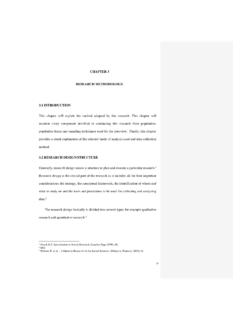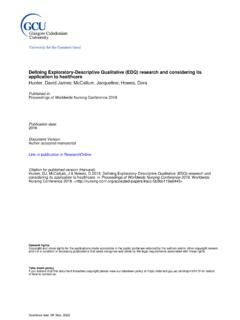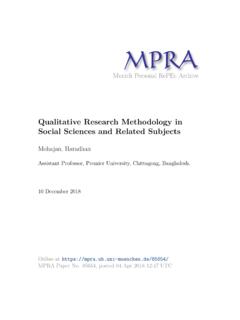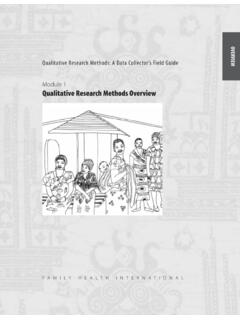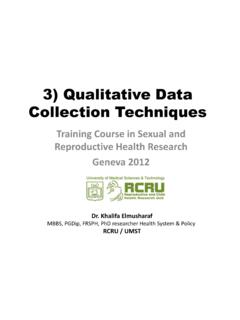Transcription of Srivastava, A. Thomson, S. B. (2009).Framework Research ...
1 srivastava , A. & thomson , S. B. ( 2009 ). framework Research Note Analysis: A qualitative Methodology for Applied Policy Research . JOAAG, Vol. 4. No. 2 framework Analysis: A qualitative Methodology for Applied Policy Research Aashish Srivastava1. S. Bruce Thomson2. Abstract Policies and procedures govern organizations whether they are private or public, for-profit or not-for- profit. Review of such policies and procedures are done periodically to ensure optimum efficiency within the organization. framework analysis is a qualitative method that is aptly suited for applied policy Research .
2 framework analysis is better adapted to Research that has specific questions, a limited time frame, a pre-designed sample and a priori issues. In the analysis, data is sifted, charted and sorted in accordance with key issues and themes using five steps: familiarization; identifying a thematic framework ; indexing; charting; and mapping and interpretation. framework analysis provides an excellent tool to assess policies and procedures from the very people that they affect. Keywords: framework analysis, applied policy Research , qualitative 1.
3 Lecturer, Department of Business Law and Taxation, Monash University, Melbourne, Australia. Email: 2. Assistant Professor, Department of International Business, St. George's University, St. George's, Grenada. 72. srivastava , A. & thomson , S. B. ( 2009 ). framework Research Note Analysis: A qualitative Methodology for Applied Policy Research . JOAAG, Vol. 4. No. 2 Introduction Organizations whether they are private or public, for-profit or not for profit are governed by a set of policies and procedures. To ensure the optimum efficiency and utilization these policies and procedures need to be reviewed periodically.
4 The review process not only assesses the success or failure of the policy or procedure it also encapsulates the implementation of these policies. The Research that undertakes this role is applied policy Research , which means that the Research is required to gather specific information and has the potential to create actionable outcomes (Ritchie & Spencer, 1994). Over the last three decades qualitative Research methods have been recognized as a valuable tool in the social sciences and in particular management studies (Denzin & Linclon, 2000, Locke, 2001) and this has spilled over into applied social policy Research (Ritchie & Spencer, 1994).
5 framework analysis is a qualitative method that is aptly suited for applied policy Research . framework analysis originated in an independent qualitative Research unit in the Social and Community Planning Research Institute situated in London, England. It was developed by two qualitative researchers, Jane Ritchie and Liz Spencer in 1994. It can be said to be quite similar to grounded theory; however, framework analysis differs in that it is better adapted to Research that has specific questions, a limited time frame, a pre-designed sample ( professional participants) and a priori issues ( organizational and integration issues) that need to be dealt with.
6 Although framework analysis may generate theories, the prime concern is to describe and interpret what is happening in a particular setting (Ritchie & Spencer, 1994). Research Methodologies Before defining exactly what framework analysis methodology entails we will briefly explain what qualitative Research is and how it is applied in policy Research . Creswell (1998) provides some conceptual clarification by defining qualitative Research as follows: qualitative Research is an inquiry process of understanding based on distinct and methodological traditions of inquiry that explore a social or a human problem.
7 The researcher builds a complex, holistic picture, analyzes words, reports detailed views of informants and conducts the study in a natural setting (p. 15). The type of methodology adopted by any Research depends upon the central Research objective and questions (Crabtree & Miller, 1999; Denzin & Lincoln, 2000). Quantitative Research methodology typically answers where, what, who and when questions (Crabtree & Miller, 1999; Silverman, 2000). However, it has been noted that quantitative Research methodologies do not adequately answer why a phenomenon occurs or how it occurs (Denzin & Lincoln, 2000; Silverman, 2000).
8 To understand the processes or the how and why of a given phenomenon qualitative Research provides the necessary in- depth and exploratory tools to achieve a clear picture of the process (Symon & Cassel, 1998). Collis, Hussey and Hussey (2003) argue that only qualitative Research in the business environment provides a stronger basis for analysis and interpretation because it is grounded in the natural environment of the phenomenon. Applied policy Research is not limited to one particular stream of data collection and methodology.
9 In fact, the use of multi methods not only provides a more in-depth data set but also allows the researcher to validate findings and thus increase the reliability of the findings (Yin, 2003). Also the use of multi methods may be necessary in order to answer the questions that initiated the Research 73. srivastava , A. & thomson , S. B. ( 2009 ). framework Research Note Analysis: A qualitative Methodology for Applied Policy Research . JOAAG, Vol. 4. No. 2 process. Within applied policy Research qualitative methods can answer the variety of questions.
10 Ritchie and Spencer (1994) have broken these down into four categories: contextual, diagnostic, evaluative and strategic (see Table 1). In qualitative Research the qualitative data is collected by the researcher and analyzed using one of the qualitative data analysis methods. qualitative data are in depth descriptions of circumstances, people, interactions, observed behaviours, events, attitudes, thoughts and beliefs and direct quotes from people who have experienced or are experiencing the phenomenon (Patton, 2002). It may also include excerpts or entire passages from personal or organizational documents such as correspondence, records/diaries, and case histories (2002).
